Introduction
Epidemic intelligence (EI) has been described as a web of human and non-human relations producing priorities about health threats to Europe and how they are handled 1. In the EU, this includes the member states (MS) Public Health Emergency Operation Centres (PHEOC), the European Centre for Disease Prevention and Control (ECDC), and the World Health Organization (WHO), the European Early Warning and Response System (EWRS), the communicable disease threats report (CDTR), disease networks EPIS (epidemic intelligence information systems), the EPIET/EUPHEM network, and various Web Scanning tools and aggregators managed by different professionals.
Various tools, systems, training programs, the International Health Regulations, and the EU legal framework define the EU EI network within and outside Europe. Technology and data collected online are central for producing this new kind of knowledge which now shapes how health security problems are understood and acted upon in the “hunt for external and internal, cross-border threats to health to be detected and contained ‘ahead of the curve’” 1.
Periodic threat reports are relevant outputs of EI activities, they allow for early awareness by a range of public health professionals, surveillance officers, researchers, practitioners, clinicians, and often the public. They also allow the mobilization of resources for surveillance, outbreak investigation, research, prevention, and control efforts.
The ECDC has the mandate to identify, assess, and communicate current and emerging threats to human health from communicable diseases in the EU 2,3 and produces a weekly report on active public health threats, the CDTR. At the MSs level, national communicable disease threats reports have been using similar methods 2,4.
In Portugal, the PHEOC at the Directorate-General of Health (DGS) has a legal mandate 5 to timely detect, verify, and rapidly assess and communicate relevant international and national health threats. The weekly Report of Observations, News, Data and Alerts (RONDA) is a regular product of the EI activities in Portugal to inform health authorities and health professionals on current international and national health threads, to promote early detection and reporting, and to improve infectious disease prevention and control.
In terms of event-based surveillance, routine information sources that are regularly reviewed and updated include international and national official sources (e.g., ECDC, the World Health Organization, and ministries of health, regional, and local public health departments), specialist aggregate websites (open-source websites that collate information on infectious disease events, such as ProMED, HealthMap, FluTrackers, and ReliefWeb), national and local media sources, and social media. Official sources of information are sought to confirm media reports. Official sources from Portugal include the Portuguese Public Health Authorities, the National Reference Laboratory, the Veterinary Authority, and other public health institutes and partners as necessary. Indicator-based surveillance can generate alerts that may or may not be reported and adds information to threats detected through event-based surveillance promoting an integrated surveillance approach that is reflected in the content of the reports of selected threats.
Threats are reported in a structured format with a headline with event, place of occurrence, date of beginning, sources of information, number of cases, and summary. For each threat, the EI team includes an overview/background of the situation, descriptive/analytical epidemiology including epicurves and maps when relevant, identification of actions taken and ongoing and recommendations for public health or health professionals or risk assessments.
Recently, interest in analysing EI threat reporting outputs has increased due to its potential for early containment, prevention, and control of all hazard health threats with large social and economic gains 6,7. A recent study has analysed threats reported in WHO Disease Outbreak News 8 until 2019 and provided recommendations on how to ensure transparency and standardization during the reporting process, which may improve the confidence and usefulness of the reports.
In general, COVID-19 impacted every aspect of public health practice. Resources and attention were allocated to the COVID-19 pandemic 9. This altered health services including public health surveillance and EI reporting of threats. To our knowledge, no analysis has been published within emergencies operational centres or EI unit contexts describing changes in reported threats during the COVID-19 pandemic. We quantified changes in reported threat trends for COVID-19 and non-COVID-19 threats to describe the possible impact of COVID-19 pandemic on EI practice to generate hypothesis for further research regarding EI threat reporting and its relevance in shaping health security, early alert and response and health prevention priorities, and to inform EI research agenda and reporting strategies in the post-acute COVID-19 period.
Methods
Data
In this descriptive study, we used the database of threats reported in RONDA, the weekly threat report of the DGS PHEOC. This consisted of a line list of all threats reported each week (including updates on previous threats in subsequent weeks), systematically registered in a structured format by a dedicated EI Officer who participated in the EI procedures. We included all threats to human health, which include threats related to disease in humans, in animals, threats related to vector spread or seasonal surveillance, mass events, and other non-infectious threats such as extreme weather events and air quality phenomena. Data included type of event, disease group, geographic focus of the communication, humans and animals affected, cross-border dimension, and relevant sources of information for each reported threat.
Statistical Analysis
We described all reported threats (both new threats and updates on previously reported threats) from January 1, 2016, to September 30, 2022, by disease groups, geographical focus, and main information sources used for the event communication. Disease groups were categorized as vaccine-preventable diseases, vector-borne diseases, emerging viral diseases (not primarily transmitted by vectors), food and water borne diseases, and influenza and other respiratory virus (IRV), tuberculosis, legionnaires disease (LD), antimicrobial resistance (AMR), and “Others,” including non-infectious threats to health and mass gatherings. The geographical focus of the reports on threats was categorized as Portugal, EURO (EEA countries and Switzerland), and the world (other locations). Threats happening in different regions of the world simultaneously may include separate reports on the threat in Portugal and others on the disease in Europe or the world. Information source was categorized as WHO, ECDC, Portuguese Public Health (including DGS Directorate-General of Health; INSA National Reference Laboratory; Local and Regional Health Authorities/Public Health Units and Departments; Directorate-General of Food and Veterinary), and others. We defined 3 periods for analysis based on the pandemic situation: period 1 - before COVID-19 (January 1, 2016-March 31, 2020); period 2 - during COVID-19 restrictions (April 1, 2020-February 28, 2022); and period 3 - post-acute COVID-19 period (March 1, 2022-September 30, 2022). In Portugal, the initial state of emergency for COVID-19 was declared on March 23. Later it was de-escalated to a state of calamity, and, on February 17, 2022, the state of calamity was deescalated to a state of alert (the minimum severity legal framework state level) and almost all restrictions and recommendations were lifted. We described the monthly average number of reported threats by period for different categories of disease groups, sources, and geographical focuses.
We compared threats’ characteristics proportions in different periods to identify possible changes in patterns of reported threats. We used a Poisson regression with link function and robust estimation to calculate a p value for the comparison of the monthly average reported threats in different periods for disease groups, geographical focus, and sources. The p value was considered significant when p value <0.05.
Finally, to capture previous trends and seasonality in comparing the periods, we used an SPSS expert modeller to find the best fitting models for the time series of non-COVID-19 threats and non-COVID-non-IRV threats until March 31, 2020. Holt-Winter’s additive models, considering seasonality, were applied to the time series, with good adjustment to the model parameters shown in the results, given by the SPSS expert modeller tool. Both models had a good fit to the time series until March 31, as demonstrated by the results. The analysis was performed using the approach described by B Tabachnich for traditional model forecasts 10. We used STATA 14 (StataCorp., TX, USA), SPSS 26 and R Statistical Software for data analyses and visualization.
Results
Of 1,202 reports on threats, we observed a decrease in reports on threats per month in period 2 compared to period 1, and there has been an increase in period 3 compared to period 1 (Fig. 1; Table 1). Non-COVID-19 threats had a large decrease in the monthly average frequency of reporting in period 2 (4.7 vs. 2.3, p < 0.001) compared to period 1, before COVID-19. There was a return to the pre-pandemic pattern of reporting in period 3 (14.67 vs. 17.63, p < 0.208) for non-COVID-19 threats with an additional increase in emerging viral diseases ( 2.20 vs. 7.62, p < 0.001).
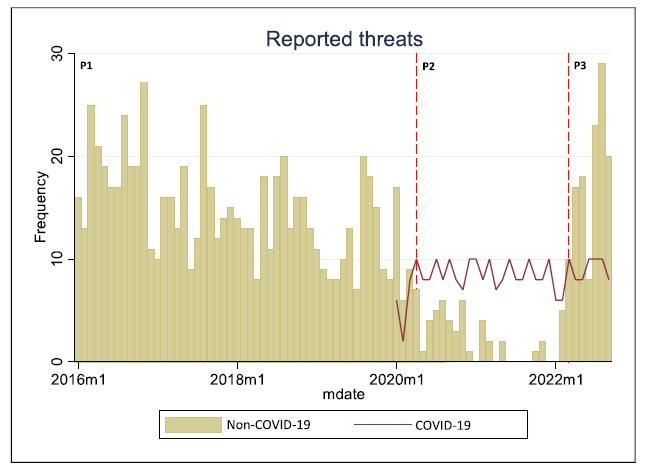
Fig. 1 Frequency of non-COVID-19 and COVID-19 threat reports in the Portuguese weekly threat report by month (n = 1,202), Portugal, January 2016-September 2022.
Table 1 Comparison of the average number of threats reported by month in different periods for a disease category, source, and geographical focus (n = 1,202), Portugal, January 2016-September 2022
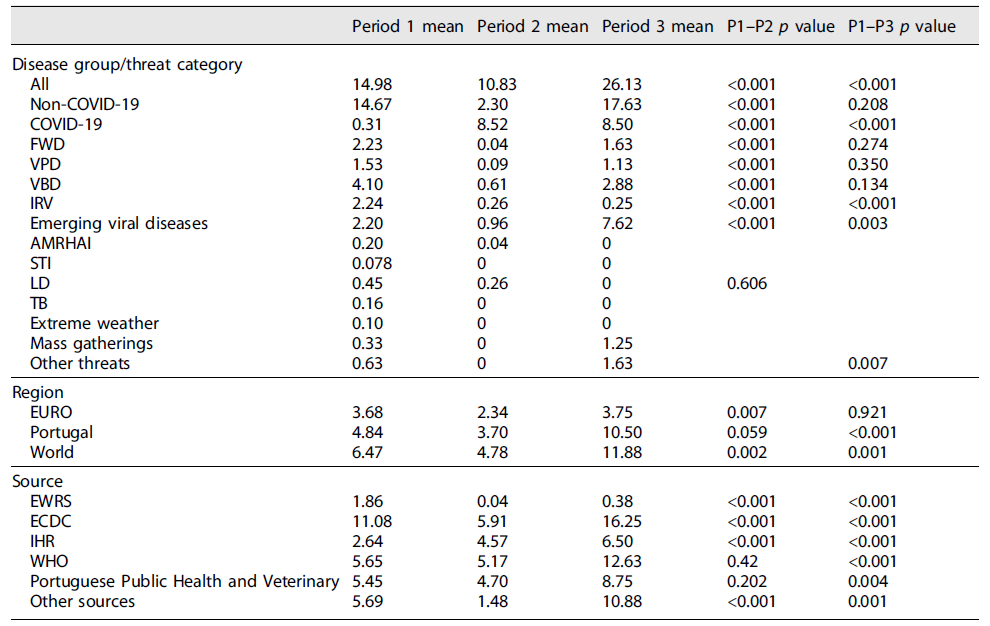
FWD, food and water borne diseases; VPD, vaccine preventable diseases; VBD, vector-borne diseases; IRV, influenza and other respiratory virus (including seasonal influenza); AMRHAI, antimicrobial resistance and healthcare associated infections; STI, sexually transmitted infections; LD, Legionnaires disease; TB, tuberculosis.
There was also a significant reduction In IRV (2.24 vs. 0.25, p < 0.001). For AMRHA, STI, LD, tuberculosis, extreme weather, mass gatherings, and other threats counts were very low in all analysed periods.
When analysing all reports on threats, there was a significant increase from period 1 to period 3 average monthly reports (14.98 vs. 26.13, p < 0.001). All non-COVID disease groups had a large significant reduction in period 2 in comparison to period 1.
The average number of reported threats from Portugal did not change significantly from period 1 to 2 but increased from period 1 to 3. The average number of reported threats from the EURO region reduced from period 1 to 2 but was not significantly different between period 1 and 3. Reported threats with a geographical focus on the world situation reduced in period 2 and increased in period 3 compared to period 1 (Fig. 2).
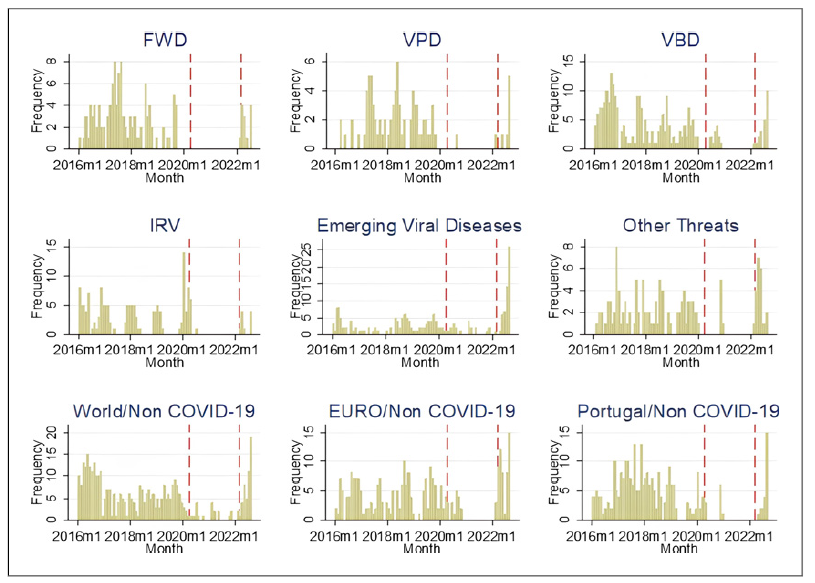
Fig. 2 Frequency of reported non-COVID-19 threats by disease group and geographic focus in the Portuguese weekly threat report by month Portugal January 2016-September 2022. FWD, food and water borne diseases; VPD, vaccine preventable diseases; VBD, vector borne diseases; IRV, influenza and other respiratory virus (including seasonal influenza); other threats, all non-COVID-19 threats not represented in the figure’s disease groups (n = 1,202), Portugal, January 2016-September 2022.
The ECDC and the WHO were overall the most frequent sources of information on threats. Compared to period 1, ECDC was a less frequent source in period 2 and more frequent in period 3. The WHO source was similar between periods 1 and 2 but increased in period 3. The Portuguese public health institutions’ sources of information had similar frequencies in periods 1 and 2 and increased in period 3 (Fig. 3).
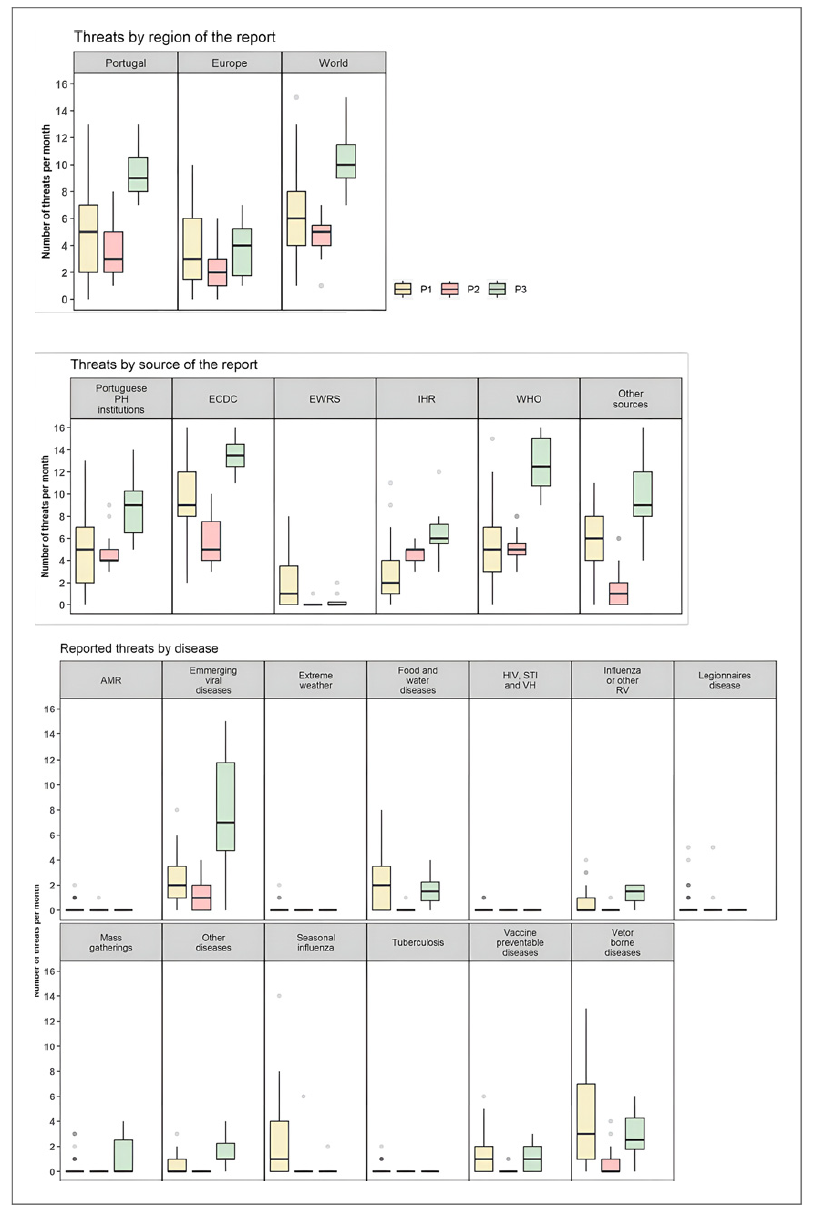
Fig. 3 Boxplots of the frequency of reported threats by month in 3 analysed periods. The monthly median, percentile 25 and 75, lower and upper limits, and outliers are represented for each analysed threat characteristic Portugal, January 2016-September 2022. FWD, food and water borne diseases. VPD, vaccine preventable diseases; VBD, vector-borne diseases; IRV, influenza and other respiratory virus (including seasonal influenza); AMRHAI, antimicrobial resistance and healthcare-associated infections, sexually transmitted infections, LD, legionnaires disease; TB, tuberculosis (n = 1,202), Portugal, January 2016-September 2022.
There were changes in threat characteristics between period 1 and period 3 in the disease group, geographic focus of the report, and sources. Although the ECDC was a very frequent source of information for threat reports (68.1% of all threats), there was a reduction in the proportion of threats with ECDC as a source from period 1 to period 3. Portuguese public health and other sources remained similar in terms of the proportion of threats when comparing these periods. There was a reduction in EWRS and IHR sources and an increase in WHO sources when comparing period 1 to period 3 (Table 2; Fig. 4).
Table 2 Comparison of the distribution of threat characteristics between period 1 and period 3, among threats reported in the Portuguese weekly threat report (n = 1,202), Portugal, January 2016-September 2022
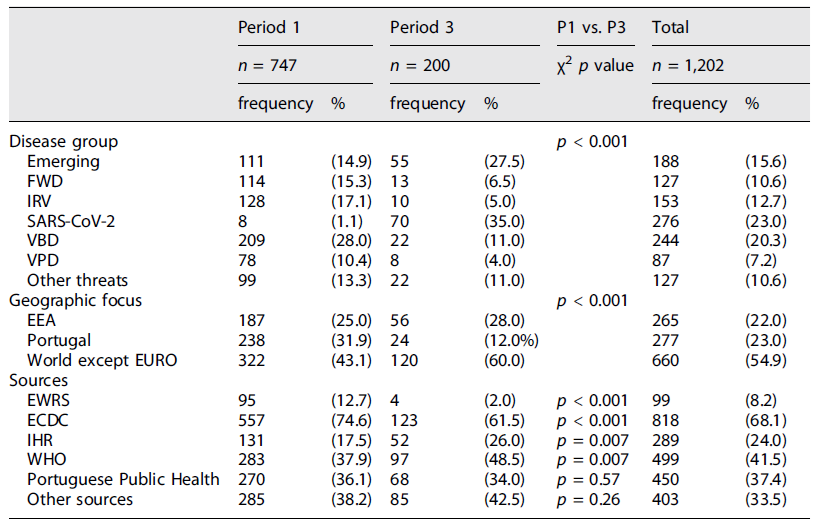
FWD, food and water borne diseases; VPD, vaccine preventable diseases; VBD, vector-borne diseases; IRV, influenza and other respiratory virus (including seasonal influenza).
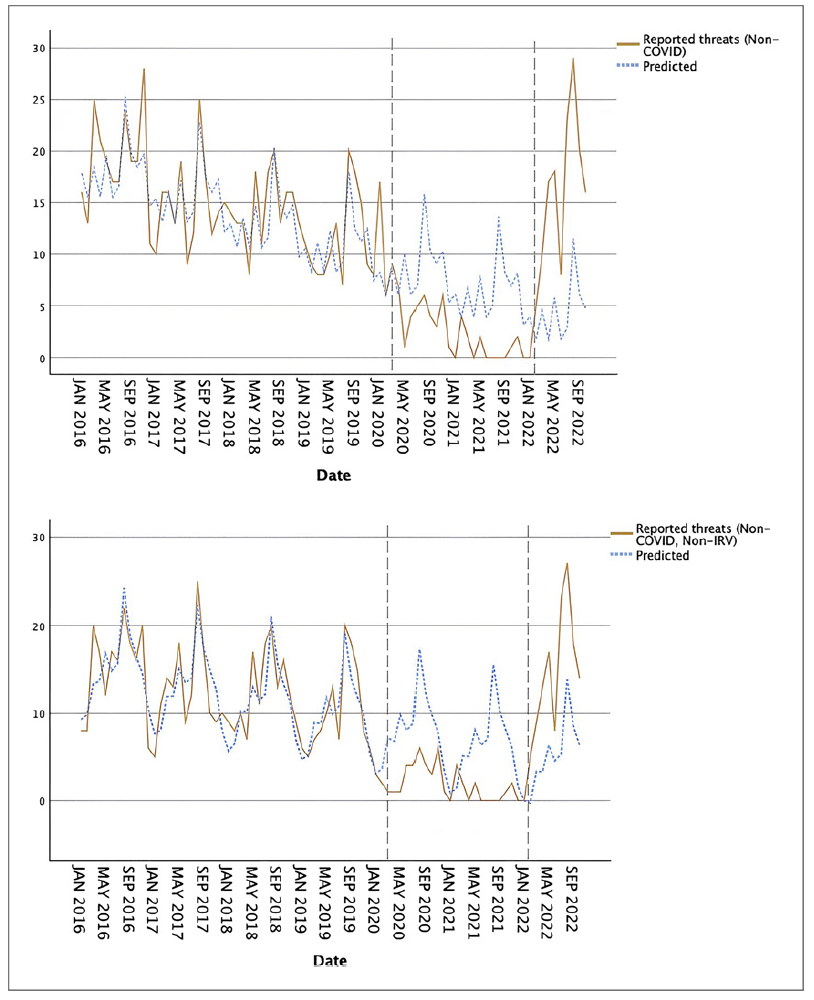
Fig. 4 Reported threats in Portuguese weekly threat report and expected reported threats, January 2016-October 2022. Portugal.
Considering observed and expected non-COVID threats, from April 2020 to January 2022, there were 114 fewer threat reports than the 162 forecasted (−70%). In period 3, from February 2022 to October 2022, there were 105 more threat reports than expected (+256%). The forecast used Winter’s Additive model (alpha-0.001; gamma-1; delta 8.947) adjusted until March 31 for the number of threats reported, R2 = 0.82, test parameters of the model p < 0.05, adjustment quality Ljung Box p = 0.66, ACF and PACF not significant.
Considering observed and expected non-COVID and non-IRV threats, from April 2020 to January 2022, there were 118 fewer threats than the 159 forecasted (−74%) in period 2. In period 3 from February 2022 to October 2022, there were 83 more threat reports than expected (+162%). The forecast used a Winter’s Additive model (alpha-0.056; gamma-5.6E−6; delta 0.001) adjusted until March 31 for the number of threats reported, stationary R2 = 0.82, test parameters of the model p < 0.05, adjustment quality Ljung Box p = 0.44, ACF and PACF not significant (Table 3).
Discussion
This is to our knowledge one of the first studies to analyse EI-reported threats in periodic threat reports during and after the acute phase of the COVID-19 pandemic. We found a large decrease (during approximately 2 years) in reported non-COVID-19 threats in the Portuguese EI weekly threat report, during the acute COVID-19 pandemic phase, and a recent return to the pre-pandemic pattern of reporting with an additional increase in emerging viral diseases reported threats. This insight can contribute to ongoing research and development efforts on EI threat detection, assessment and reporting in Europe, including on registries and databases of EI threat detection, assessment, and reporting, generating useful information on threats for analysis of trends, characteristics, communication objectives, recommendations, sources for initial signals, and other information. Ultimately, this may contribute to a better understanding of EI procedures and outputs allowing sharing of experiences and improvement of policy and practice in this area.
We speculate that this phenomenon may have occurred in communicable diseases threat reports from international institutions which are important sources for MS EI threat reporting like the ECDC (CDTR) and the WHO. In this analysis, the ECDC and the WHO were the most frequent information sources for specific threats in all 3 periods. Threat identification and prioritization for communication may be influenced by changes in public health practice, resource allocation, indicator and event-based surveillance quality, disease burden, and social focus 11. Different allocations of limited surveillance and EI human resources, and limited automation tools, may contribute to changing surveillance, signal detection, assessment, and reporting practices. Some non-COVID-19 threats may have not been detected or under-ascertained during the COVID-19 acute pandemic phase at different levels. COVID-19 burden of disease could partly justify this change as resources were directed at the threat with higher disease burden and higher social focus 12. Further analysis and comparison of the intensity of threat reporting and disease burden could also give useful contributions to EI reporting, even though for various reasons this analysis should be made with caution because of different communication, prevention, and control objectives for different types of diseases and different stages of prevention and control. For example, early reporting on low-burden diseases may allow early preventive efforts to make them remain a low-burden disease and this can be more cost-effective than later control efforts for most infectious diseases, in most contexts.
Although some COVID-19 restrictions could justify a reduction in reported threats for specific disease groups (e.g., IRV, vaccine-preventable diseases), we argue that it is unlikely that the dimension of the observed reduction in most other threats was entirely due to the absence of those threats. This is supported by our finding that observed non-COVID threats were still lower than expected using forecast methods considering trends and seasonality, even when modelling the forecast exclusively for non-COVID-non-IRV threats.
We speculate that there may have been changes in surveillance and outbreak investigation of non-COVID-19 threats in some contexts, and changes in the threshold for inclusion in weekly threat reports. Because of limited public health and surveillance human resources, a concentration of attention of public health workers and field epidemiologists on COVID-19 may have contributed to the observed phenomenon. Furthermore, editorial factors can influence threat reporting, depending on internal discussion and different communication objectives. We speculate that thresholds for communication of detected threats under assessment may change in relation to other ongoing threats in certain periods considering the presented results. Changes in health-seeking behaviour for other diseases, and changes in diagnostic and notification practices by clinicians may also have changed during this period. COVID-19 was resource-intensive in terms of contact tracing (led by public health professionals at different levels), surveillance, EI and reporting, intervention epidemiology, and operational research efforts. Furthermore, apart from the reduction in people’s movement globally, many other activities related to other disease groups did not suffer such dramatic changes (food production and distribution regarding food and water borne diseases, trade routes, and outbreaks in endemic and non-endemic settings and endemic vector-borne diseases). Furthermore, after the spring of 2021, there was a tendency for normalization of people’s movement and contact within countries and around the world 13, but we only observed an increase in reporting of other threats after February 2022 when, in Portugal, the state of calamity was deescalated to a state of alert (the minimum severity legally framework state level) and almost all restrictions and recommendations were lifted.
After 2 years of a decrease in reporting of non-COVID-19 threats, in the most recent analysed period, there was an increase in observed reports on threats comparing expected (forecasted threats) and observed reports on threats merging viral disease had the largest increase considering average monthly counts. This change is probably multifactorial; human resources allocation, changes in surveillance and reporting threats, and a higher focus on human-to-human transmission after COVID-19 in surveillance and EI can be considered. For non-COVID-19 threats, a normalization of epidemic patterns, surveillance, and EI reporting practices in specific disease groups may justify the growth in reporting in period 3.
International sources are relevant for national EI threat reports 14. In Portugal, the IHR event information system, the EWRS, the ECDC CDTR, and WHO DON are important sources for the selection of international threats to include in periodic reporting. It is possible that similar phenomena of reduction in non-COVID threats may be found in other communicable disease threat reports, from national and international institutes and agencies and, should be researched and understood along with its impact in priority settings, clinical and public health professionals’ awareness and resource allocation for other health threats prevention and control.
Overall number of reported threats increased from period 1 to period 3 which should further raise awareness towards a need to increase EI resources and improve EI tools. On one side, it is possible that more threats are being identified and reported on the other, besides the previously discussed hypothesis, it is possible that the threshold for what would be a threat worthy of reporting may be changing according to communication objectives and priorities related to preparedness and response. Communication of threats should ultimately be guided by usefulness for preparedness and response, practice, and policy, and to mobilize, activate or guide resources for surveillance, prevention, and control around a specific threat. There are many examples in which communication of threats is important to enhance surveillance, prevention, and control. This can only be fully achieved by informing public health professionals, health authorities, clinicians, public health practitioners, policymakers and even the public, often through the media. The global network of EI and threat reporting is fundamental for these processes.
The proportion of threats in different disease groups, and geographical focus changed from period 1 to period 3 with an increase in the proportion of emerging viral diseases and a reduction in other categories. This may be related to continuing COVID-19 reporting, the Monkeypox re-emergence, and other potential emerging viral diseases of interest. There were changes in the proportion of sources used for threats between period 1 that can be further researched to understand its causes and understand EI practices in different moments and contexts, including the importance of the ECDC and WHO reporting on national EI activities and the importance of national official sources and public health network and its usefulness. Threat reporting is not representative of all threats, but of surveillance functioning, outbreak detection and investigation, risk assessments, international reporting and national reporting practices, communication priorities and objectives and perceived usefulness as information for action.
The discussion around EI resources and tools can no longer be separated from artificial intelligence (AI) 15. EI development agenda must consider and guide the introduction and growth of AI and open AI in the generation of potentially more alert signals and in the learning to filter threats, to adequately assess and select those that are of higher risk for public health for early warning and response. This may allow for earlier detection and decision-making that can prevent the reemergence of known diseases and, potentially, the next pandemic, or buy us time for targeted preparedness and response activities. However, selection for reporting and communication of threats will continue to need human assessment and decision, even if supported by emerging technology.
We found an increase in threats reported with a geographical focus on Portugal and the rest of the World, compared to threats in Europe, outside Portugal. This generates a hypothesis that more attention is being paid to potential global threats. Threats in Portugal are getting more attention or are more often being detected. Portuguese public health as a source of information for specific threats has also increased in period 3 compared to period 1. This may be partly justified by frequent updates on COVID-19, monkeypox and more frequent local and regional threats and communications using information from local, regional, and national level surveillance, public health services, and health authorities.
The EI network should continue to clarify EI’s dynamic objectives and standardize methods across countries to increase usefulness and comparability. EI functioning is inseparable from strong and timely event-based and indicator-based surveillance and preparedness activities. Guidelines for EI threat reporting can be further developed. However, risk assessment and EI reporting processes will continue to demand flexibility as different types of threats, contexts and geographical perspectives require different types of expertise and assessment methods, partners and may have different communication objectives and target audiences considering the magnitude, social transcendence, capacity to respond, uncertainty and the threat communication potential to improve preparedness and response. Evaluations of usefulness for different recipients and readers of reports may help by documenting reach and guiding improvements. EI reporting in different MSs, the ECDC and the WHO could be further compared, to strengthen a common vision of the role and procedures of EI threat reporting in global public health 8.
EI practices and tools used vary among countries 16,17. The development of EI should include a research agenda on EI outputs such as threat reporting as this is a powerful tool to define priorities that can mobilize resources for early prevention and control while contributing to cascading knowledge and good practices.
EI threat reporting in MS is a relatively recent endeavour and there are different focuses and practices 18. There are published studies related to EI activities 19 but only a few focused on reported threats 20,21.
Conclusion
There was a lower reporting of public health threats during the COVID-19 acute period in the Portuguese weekly EI threat report. Changes in threat reporting priorities and their causes can help inform European and global EI strategic planning 8 while reassessing objectives, usefulness, training, tools, and human resource needs in a post-pandemic world. Further efforts should be made to understand what factors influence threat reporting priorities and, at a later stage, its impact on preparedness and response to future threats of different diseases. We recommend strengthening and standardizing of monitoring and evaluation of threat reporting procedures. The later increase in reported threats raises awareness of the importance of strengthening surveillance and EI activities and guaranteeing workforce, and effective tools beyond the COVID-19 pandemic to early detect, report, and respond to global and regional health security threats.
Statement of Ethics
Ethical review and approval were not required for this study of reported public health threats in study in accordance with the national legislation and the institutional requirements.















